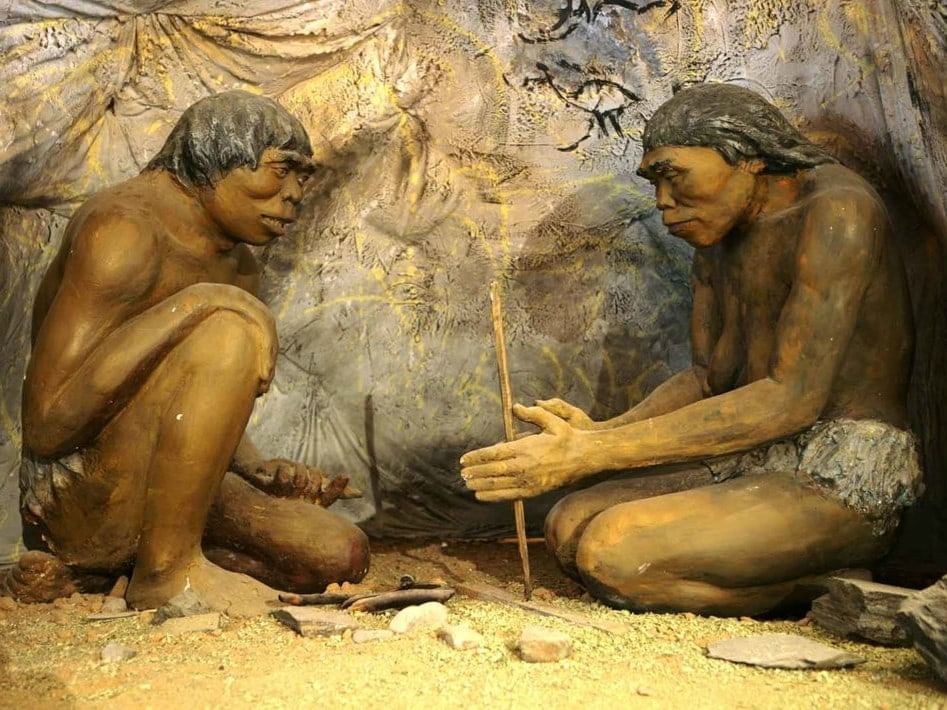- Palaeolithic Period: 2 million BC - 10,000 BC
- Mesolithic period: 10,000 BC - 8000 BC
- Neolithic Period: 8000 BC - 4000 BC
- Chalcolithic Period: 4000 BC - 1500 BC
- Iron Age: 1500 BC - 200 BC
- Lower Palaeolithic Age: up to 100,000 BC
- Middle Palaeolithic Age: 100,000 BC - 40,000 BC
- Upper Palaeolithic Age: 40,000 BC - 10,000 BC
 Old Stone Age
Old Stone Age
- Hunters and food gatherers; tools used were axes, choppers and cleavers.
- Earliest lower Palaeolithic site is Bori in Maharashtra.
- Limestone was also used to make tools
- Soan valley (in present Pakistan)
- Sites in the Thar Desert
- Kashmir
- Mewar plains
- Saurashtra
- Gujarat
- Central India
- Deccan Plateau
- Chotanagpur plateau
- North of the Cauvery River
- Belan valley in UP
There are habitation sites including caves and rock shelters.
It was declared a World Heritage Site in 2003
An important place is Bhimbetka in Madhya Pradesh
Middle Palaeolithic age
- Tools used were blades, pointers, scrapers and borers.
- The tools were smaller, lighter and thinner
- Important middle Palaeolithic age sites
- Belan valley in UP
- Luni valley (Rajasthan)
- Son and Narmada rivers
- Bhimbetka
Upper Palaeolithic age
- Emergence of Homo sapiens
- Lot of bone tools, including needles, harpoons, blades, fishing tools and burin tools.
Major sites of Upper Palaeolithic age
- Belan
- Son
- Chota Nagpur plateau (Bihar)
- Maharashtra
- Orissa and
- Eastern Ghats in Andhra Pradesh
- Paintings at Bhimbetka site belong to this age.
Mesolithic Period (Middle Stone Age)
- Major climate change happened
- Climate became warmer and more humid.
- Rainfall increased and so more availability of flora and fauna.
- Domestication of animals and plants were seen for the first time.
- Started 12000 years ago.
- First animal to be domesticated was the wild ancestor of the dog.
- Sheep and goats were the most common domesticated animals.
- Hunting and food gathering continued.
- First human colonization of the Ganga plains.
- Microliths have been excavated.
- They are small stone tools that were probably stuck to stones to be used as saws and sickles.
Major sites:
- Brahmagiri (Mysore)
- Narmada
- Vindhya
- Gujarat
- UP
- Sojat (Rajasthan)
- Bhimbetka
- Godavari Basin
- Sarai Nahar Rai
- Tools used were blades, crescents, triangles, trapezes, spearheads, knives, arrowheads, sickles, harpoons and daggers.
In the world context, the New Stone age or the Neolithic age began in 9000 BC which is when agriculture was developed in South west Asia.
- The Neolithic settlers were the earliest farming communities.
- They domesticated cattle, sheep and goats in the initial stage.
- Subsequently, agriculture and other activities were started with the help of both stone and bone tools.
- People lived in circular or rectangular houses made of mud and reed.
- It is held that the primitive people living in circular houses owned property in common.
- The Neolithic pottery included black-furnished ware, grey ware and mat-impressed ware.
- The Neolithic people led a settled life and produced ragi and kulathi and even rice.
- Mehrgarh is a famous Neolithic settlement in the subcontinent which is attributed to 7000 BC. It is situated in Baluchistan province, - Pakistan.
- It is one of the largest Neolithic settlements between the Indus River and the Mediterranean Sea.
- It is located on the bank of the Bolan River in the Kacchi plain which is called the bread basket of Baluchistan.
- The Neolithic people of Mehrgarh were more advanced. They produced wheat and barley and lived in mud-brick houses.
No comments:
Post a Comment